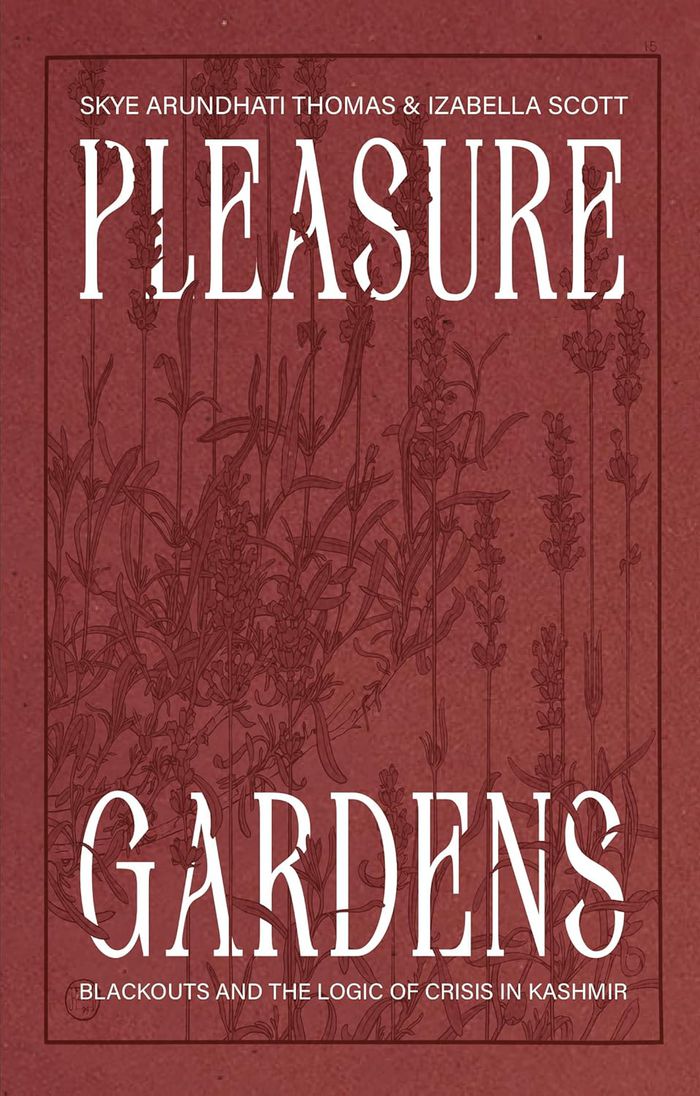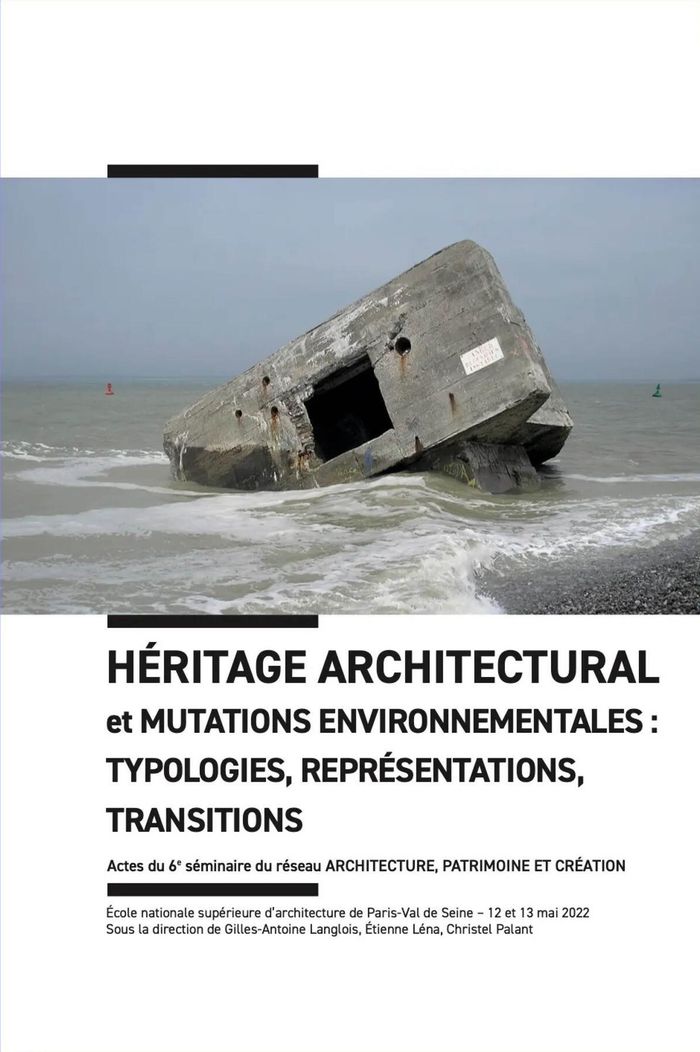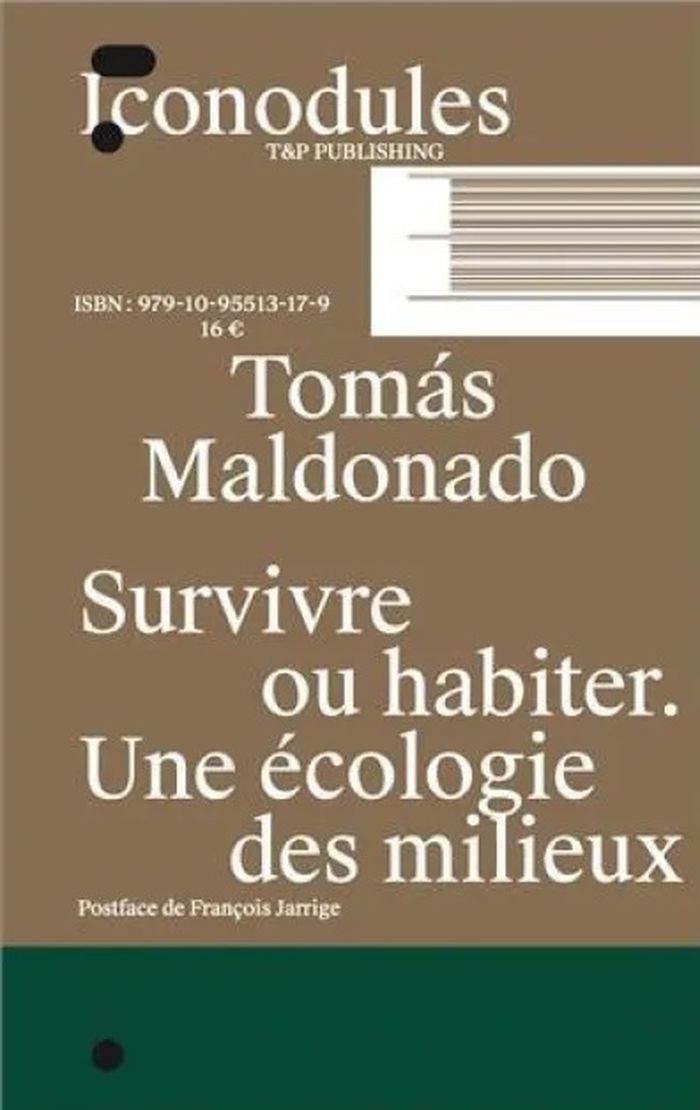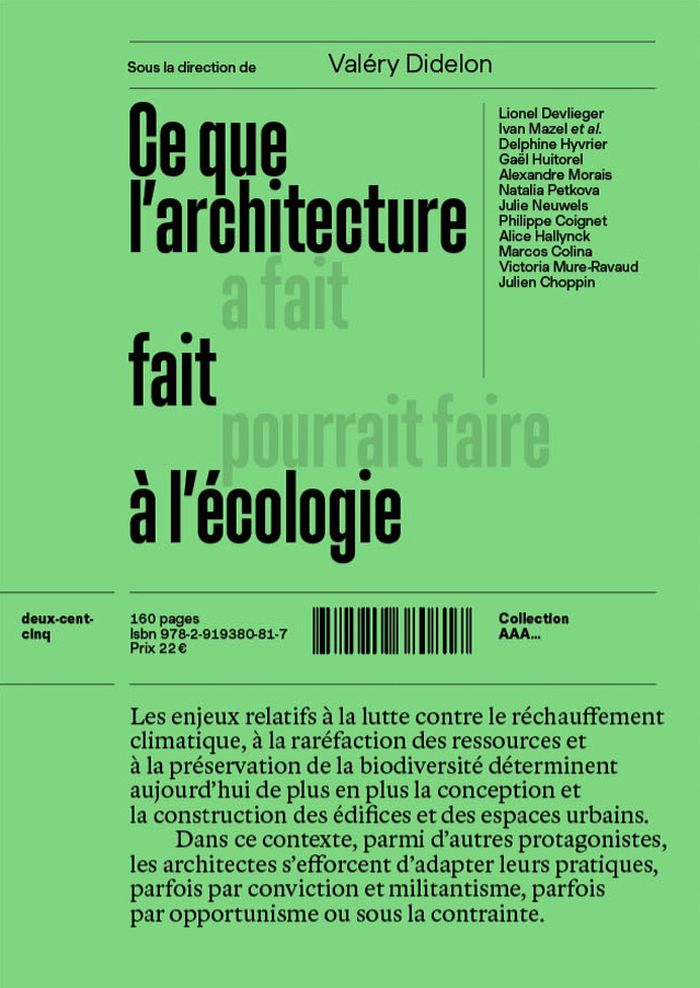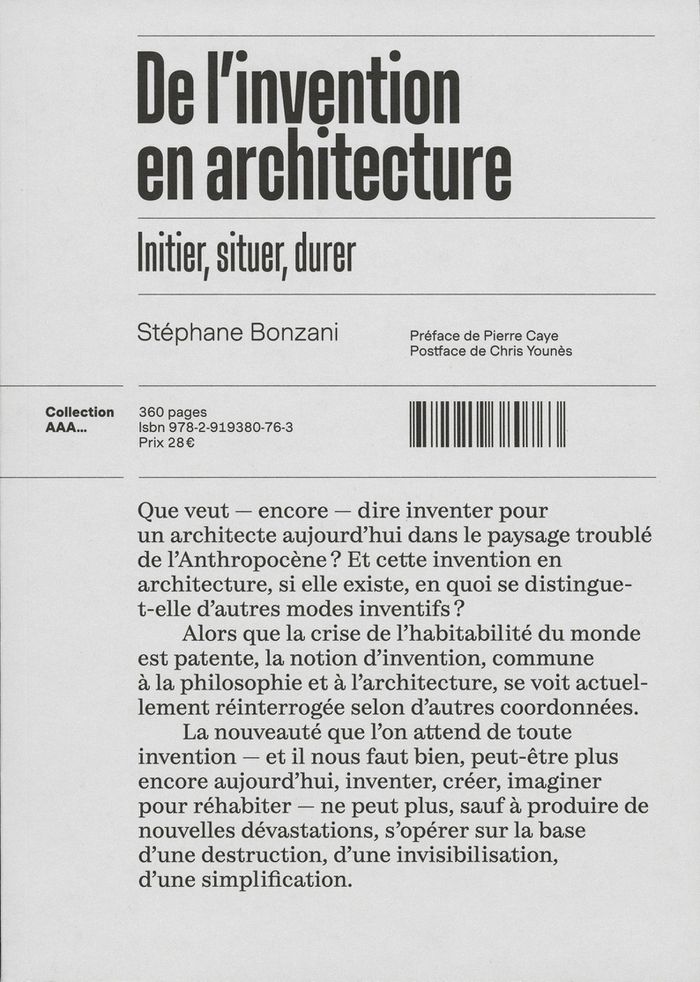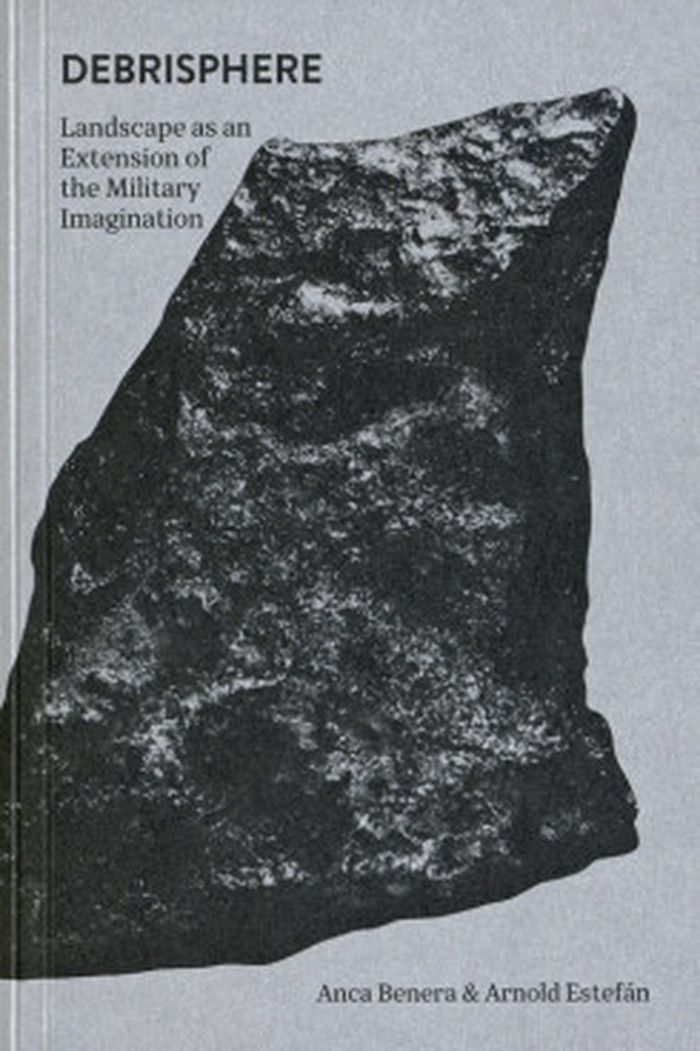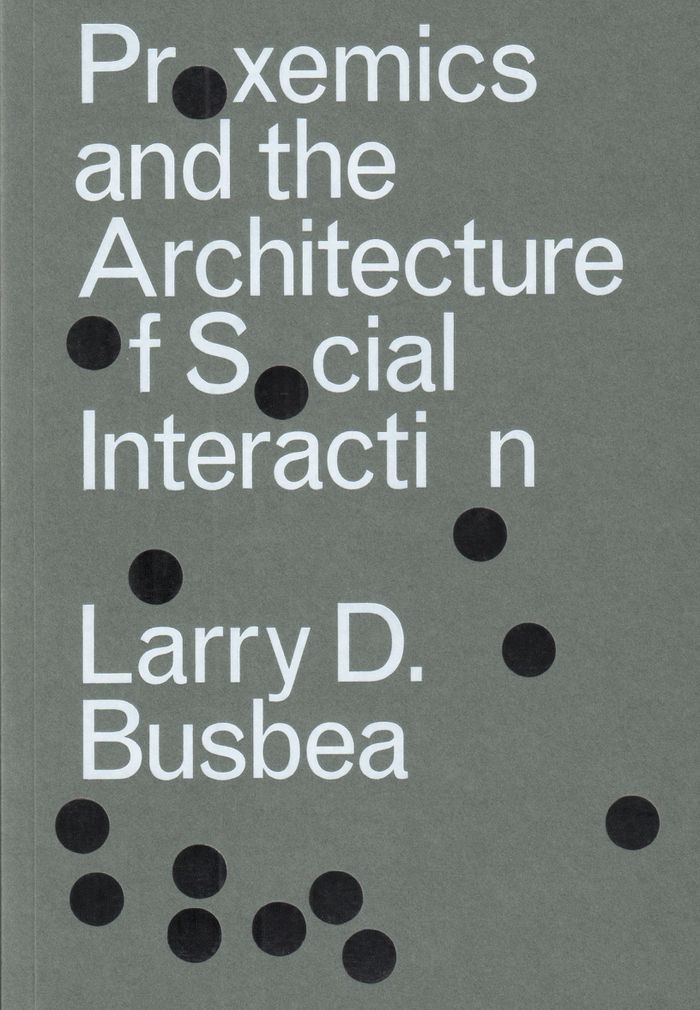$25.00
(disponible en magasin)
Résumé:
This essay-led book project by Izabella Scott and Skye Arundhati Thomas examines ongoing land disputes, military occupation, and communication blackouts. Through an extended text and a selection of photo essays made in collaboration with photographers, the project gathers together records produced under daily surveillance and confrontation. It seeks a new register of(...)
L'écologie de l'architecure
mai 2024
Pleasure gardens: Blackouts and the logic of crisis in Kashmir
Actions:
Prix:
$25.00
(disponible en magasin)
Résumé:
This essay-led book project by Izabella Scott and Skye Arundhati Thomas examines ongoing land disputes, military occupation, and communication blackouts. Through an extended text and a selection of photo essays made in collaboration with photographers, the project gathers together records produced under daily surveillance and confrontation. It seeks a new register of writing and image to make visible the conditions of military occupation and the protracted violence of the blackout.
L'écologie de l'architecure
Héritage architectural et mutations environnementales: typologies, représentations, transitions
$22.50
(disponible en magasin)
Résumé:
Actes du 6e séminaire du réseau pédagogique et scientifique « Architecture, Patrimoine et Création. » Le séminaire s'est déroulé à l'ENSA de Paris-Val de Seine, du 12 et 13 mai 2022. Malgré de nombreux travaux et discussions autour de la question d’une architecture « écologique », peu d’entre eux évoquent le patrimoine architectural existant et ancien. De ce fait, le(...)
Héritage architectural et mutations environnementales: typologies, représentations, transitions
Actions:
Prix:
$22.50
(disponible en magasin)
Résumé:
Actes du 6e séminaire du réseau pédagogique et scientifique « Architecture, Patrimoine et Création. » Le séminaire s'est déroulé à l'ENSA de Paris-Val de Seine, du 12 et 13 mai 2022. Malgré de nombreux travaux et discussions autour de la question d’une architecture « écologique », peu d’entre eux évoquent le patrimoine architectural existant et ancien. De ce fait, le réseau pédagogique et scientifique « Architecture, patrimoine et création », souhaite élargir cette préoccupation à d’autres périodes mais aussi, aux architectures ordinaires et vernaculaires. Les travaux du colloque s’inscrivent dans une histoire environnementale de l’architecture, de l’urbain et du paysage. En effet, cette préoccupation pousse l’architecte, l’urbaniste et le paysagiste à faire face à de nombreux questionnements et redéfinir le périmètre de la notion de patrimoine.
L'écologie de l'architecure
$35.00
(disponible en magasin)
Résumé:
« Avoir un abri n'est pas encore habiter. Habiter, comme on le dit à juste titre, c'est s'installer. C'est précisément un nouveau front ; des actions vastes et complexes seront nécessaires pour rendre la vie sur la planète plus supportable. Ce sont ces nouvelles tâches auxquelles nous devons nous atteler. » Tomás Maldonado. Les essais réunis pour la première fois en(...)
Survivre ou habiter : Une écologie des milieux
Actions:
Prix:
$35.00
(disponible en magasin)
Résumé:
« Avoir un abri n'est pas encore habiter. Habiter, comme on le dit à juste titre, c'est s'installer. C'est précisément un nouveau front ; des actions vastes et complexes seront nécessaires pour rendre la vie sur la planète plus supportable. Ce sont ces nouvelles tâches auxquelles nous devons nous atteler. » Tomás Maldonado. Les essais réunis pour la première fois en français dans cet ouvrage rendent compte des préoccupations environnementales de Tomás Maldonado (1922-2018). Figure intellectuelle totale et reconnue en Italie, Maldonado était aussi designer, théoricien et sémioticien, scrutant l'implication et les responsabilités des designers et des architectes. En abordant les questions de la reconstruction de la nature, de la relation au monde animal ou encore de la qualité des modes de vie, il tente d'éveiller une conscience écologique critique.
L'écologie de l'architecure
$44.00
(disponible en magasin)
Résumé:
En contrepoint de l'abondante littérature existante qui porte sur ce que l'écologie fait à l’architecture, le présent ouvrage renverse la perspective et ouvre un débat. Les auteurs rassemblés au sein de l’ouvrage, chercheurs et praticiens, s'interrogent en effet sur les multiples manières qu’ont les acteurs de l'aménagement des espaces construits — architectes,(...)
Ce que l'architecture fait à l'écologie
Actions:
Prix:
$44.00
(disponible en magasin)
Résumé:
En contrepoint de l'abondante littérature existante qui porte sur ce que l'écologie fait à l’architecture, le présent ouvrage renverse la perspective et ouvre un débat. Les auteurs rassemblés au sein de l’ouvrage, chercheurs et praticiens, s'interrogent en effet sur les multiples manières qu’ont les acteurs de l'aménagement des espaces construits — architectes, paysagistes, ingénieurs, etc. — de façonner les attentes de la société en matière de lutte contre le dérèglement climatique, l’épuisement des ressources et l’effondrement de la biodiversité. Ce que l’architecture fait à l’écologie montre que leurs pratiques et discours déterminent les conditions de production du cadre bâti autant qu’ils sont déterminés par celles-ci. Dans cet ouvrage, l’architecture est ainsi considérée comme l’un des laboratoires où s’inventent la technique, l’esthétique et plus encore l’éthique qui peut orienter et guider l’action collective dans le monde qui vient.
L'écologie de l'architecure
$52.00
(disponible en magasin)
Résumé:
La moyenne montagne est un territoire à l’avant-poste de la crise climatique et de l’habitabilité que nous connaissons. Le réchauffement y est en effet deux fois plus rapide que partout ailleurs. Les conséquences sont évidentes, implacables: disparition de la neige et son corollaire économique qui met à mal une dynamique enclenchée pendant les Trente Glorieuses et les(...)
À l'école des sentinelles : Re-faire architecture
Actions:
Prix:
$52.00
(disponible en magasin)
Résumé:
La moyenne montagne est un territoire à l’avant-poste de la crise climatique et de l’habitabilité que nous connaissons. Le réchauffement y est en effet deux fois plus rapide que partout ailleurs. Les conséquences sont évidentes, implacables: disparition de la neige et son corollaire économique qui met à mal une dynamique enclenchée pendant les Trente Glorieuses et les investissements des plans neige. Que faire alors des infrastructures et du bâti — patrimoine architectural ordinaire du XXe siècle? Est-il voué à l’abandon, à disparaître? Ce livre relate une expérience simultanément pédagogique, humaine, technique et prospective. Celle de l’hôtel des Deux-Sœurs au col de l’Arzelier et de sa possible réhabilitation imaginée par une équipe engagée dans la compétition Solar Decathlon Europe 2021-2022.
L'écologie de l'architecure
$52.00
(disponible sur commande)
Résumé:
Que veut — encore — dire inventer pour un architecte aujourd’hui dans le paysage troublé de l’Anthropocène? Et cette invention en architecture, si elle existe, en quoi se distingue-t-elle d’autres modes inventifs? Alors que la crise de l’habitabilité du monde est patente, la notion d’invention, commune à la philosophie et à l’architecture, se voit actuellement(...)
De l'invention en architecture : Initier, situer, durer
Actions:
Prix:
$52.00
(disponible sur commande)
Résumé:
Que veut — encore — dire inventer pour un architecte aujourd’hui dans le paysage troublé de l’Anthropocène? Et cette invention en architecture, si elle existe, en quoi se distingue-t-elle d’autres modes inventifs? Alors que la crise de l’habitabilité du monde est patente, la notion d’invention, commune à la philosophie et à l’architecture, se voit actuellement réinterrogée selon d’autres coordonnées. La nouveauté que l’on attend de toute invention — et il nous faut bien, peut-être plus encore aujourd’hui, inventer, créer, imaginer pour ré-habiter — ne peut plus, sauf à produire de nouvelles dévastations, s’opérer sur la base d’une destruction, d’une invisibilisation, d’une simplification.
L'écologie de l'architecure
$35.95
(disponible en magasin)
Résumé:
From the late nineteenth through most of the twentieth century, the evangelical Protestant Grenfell Mission in Newfoundland and Labrador, Canada, created a network of hospitals, schools, orphanages, stores, and industries with the goal of bringing health and organized society to settler fisherfolk and Indigenous populations. This infrastructure also served to support(...)
Slow disturbance: infrastructural mediation on the settler colonial resource frontier
Actions:
Prix:
$35.95
(disponible en magasin)
Résumé:
From the late nineteenth through most of the twentieth century, the evangelical Protestant Grenfell Mission in Newfoundland and Labrador, Canada, created a network of hospitals, schools, orphanages, stores, and industries with the goal of bringing health and organized society to settler fisherfolk and Indigenous populations. This infrastructure also served to support resource extraction of fisheries off Labrador's coast. In 'Slow Disturbance' Rafico Ruiz engages with the Grenfell Mission to theorize how settler colonialism establishes itself through what he calls infrastructural mediation—the ways in which colonial lifeworlds, subjectivities, and affects come into being through the creation and maintenance of infrastructures. Drawing on archival documents, maps, interviews with municipal officials, teachers, and residents, as well as his field photography, Ruiz shows how the mission's infrastructural mediation—from its attempts to restructure the local economy to the aerial surveying and mapping of the coastline—responded to the colony's environmental conditions in ways that expanded the bounds of the settler frontier. By tracing the mission's history and the mechanisms that enabled its functioning, Ruiz complicates understandings of mediation and infrastructure while expanding current debates surrounding settler colonialism and extractive capitalism.
L'écologie de l'architecure
$36.95
(disponible en magasin)
Résumé:
In this book, Brenna Bhandar examines how modern property law contributes to the formation of racial subjects in settler colonies and to the development of racial capitalism. Examining both historical cases and ongoing processes of settler colonialism in Canada, Australia, and Israel and Palestine, Bhandar shows how the colonial appropriation of indigenous lands depends(...)
Colonial lives of property: law, land, and racial regimes of ownership
Actions:
Prix:
$36.95
(disponible en magasin)
Résumé:
In this book, Brenna Bhandar examines how modern property law contributes to the formation of racial subjects in settler colonies and to the development of racial capitalism. Examining both historical cases and ongoing processes of settler colonialism in Canada, Australia, and Israel and Palestine, Bhandar shows how the colonial appropriation of indigenous lands depends upon ideologies of European racial superiority as well as upon legal narratives that equate civilized life with English concepts of property. In this way, property law legitimates and rationalizes settler colonial practices while it racializes those deemed unfit to own property. The solution to these enduring racial and economic inequities, Bhandar demonstrates, requires developing a new political imaginary of property in which freedom is connected to shared practices of use and community rather than individual possession.
L'écologie de l'architecure
$39.95
(disponible en magasin)
Résumé:
Debrisphere is a yet-unnamed stratum of Earth's crust, a supra-stratum of the Lithosphere. It contains the worldwide man-made landscapes: the artificial mountains of Germany, the “blooming deserts” of Israel, the military coral reefs of China and the United States, and other similar constructions around the world resulted from, or still serving, conflict and war. The(...)
Debrisphere: Landscape as an extension of the military imagination
Actions:
Prix:
$39.95
(disponible en magasin)
Résumé:
Debrisphere is a yet-unnamed stratum of Earth's crust, a supra-stratum of the Lithosphere. It contains the worldwide man-made landscapes: the artificial mountains of Germany, the “blooming deserts” of Israel, the military coral reefs of China and the United States, and other similar constructions around the world resulted from, or still serving, conflict and war. The artist's book by Anca Benera and Arnold Estefan is published as an extension to their eponymous installation, presented for the first time in the frame of “Natural Histories. Traces of the Political” exhibition at MUMOK Vienna in 2017. Alongside the artists' case studies, which include Ariel Sharon Park, Teuflesberg, Diego Garcia, Johnston Atoll and the Spartly Islands, the publication includes four republished texts by Andrew Chubb, Hito Steyerl and Eyal Weizman, and newly commissioned texts by Noit Banai, Maja & Reuben Fowkes and Raluca Voinea.
L'écologie de l'architecure
$32.00
(disponible en magasin)
Résumé:
Architecture is a constant presence in the study of human interaction- acting as both the ground on which human social behavior is performed and a means of shaping subjectivity itself. ''Proxemics'' was an attempt to visualize and instrumentalize these dynamics, appealing to both the social sciences and the emerging field of environmental design. Founded by anthropologist(...)
Proxemics and the architecture of social interaction
Actions:
Prix:
$32.00
(disponible en magasin)
Résumé:
Architecture is a constant presence in the study of human interaction- acting as both the ground on which human social behavior is performed and a means of shaping subjectivity itself. ''Proxemics'' was an attempt to visualize and instrumentalize these dynamics, appealing to both the social sciences and the emerging field of environmental design. Founded by anthropologist Edward T. Hall and taking shape between the departments of architecture and anthropology at the Illinois Institute of Technology, proxemics developed amidst cold war political tensions and intense social and civil unrest. ''Proxemics and the Architecture of Social Interaction'' presents selections from Hall’s extensive archive of visual materials alongside a critical analysis that traces transformations in the fields of design and science. Together these materials illuminate a moment in American history when new spatial practices arose to challenge the environmental conditions of cultural, political, and racial identity.
L'écologie de l'architecure
